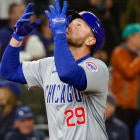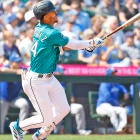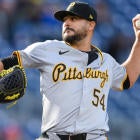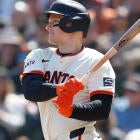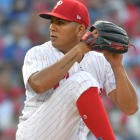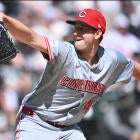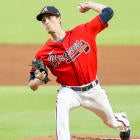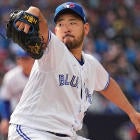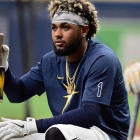A baseball team starts three times as many players in the outfield than at any other position. So naturally, you can expect this list to be three times as long as the other prospect lists, profiling 30 players instead of the usual 10.
Um, not quite.
Limiting the list to 20 should still give you a thorough overview of the players with the best chance of making a Fantasy impact, both in the short-and long-term, especially when you consider that many of the game's best outfielders actually came up as infielders, moving either to fill a specific need or because they were making too many darn errors.
Plus, you'd never be able to read through a full 30 profiles in one sitting. I'm considerate like that.
Note: This list has been adjusted for Fantasy purposes. Long-term potential is one of several factors that influence the order and is arguably less important than the player's expected role in 2012. These prospects don't all profile as superstars, but they're the names most worth knowing in Fantasy right now.
1. Bryce Harper, 19, Nationals
Where
played in 2011: Class A, Double-A
Minor-league stats: .297
BA (387 at-bats), 17 HRs, 26 SBs, .894 OPS
Yup. That's the most succinct way to describe Harper's first professional season. The first overall pick in the 2010 draft responded to being the most hyped position player in draft history by doing everything he was supposed to do. He dominated at Class A, showing prodigious power with decent plate discipline, and advanced to Double-A before season's end. Granted, he struggled after the promotion, but for an 18-year-old in his first professional season, the performance was as good as anyone could have expected. Besides, he made the necessary adjustments to finish on a high note, so the stint is hardly a blemish on his record. Those adjustments carried over to the Arizona Fall League, where he hit .333 with six homers and a 1.034 OPS in 93 at-bats, only adding to the anticipation. Everything went so well for Harper in his first season that he might actually be in the running for the starting right field job in spring training. A midseason promotion is more likely, but the bottom line is his major-league debut is just around the corner. You wouldn't be crazy to stash Harper in a standard mixed league, and obviously, he's a must-have in long-term keeper formats. Prospects don't get any better than him.
2. Yonder Alonso, 24, Reds
Where
played in 2011: Triple-A, majors
Minor-league stats: .296
BA (358 at-bats), 12 HRs, .860 OPS, 46 BBs, 60 Ks
Major-league
stats: .330 BA (88 at-bats), 5 HRs, .943 OPS, 10 BBs, 21 Ks
Alonso isn't any more an outfielder than Shaquille O'Neal is a rapper, but sometimes the powers that be are willing to fit a square peg into a round hole for the sake of the numbers it might generate. The problem for the Reds is that Alonso's numbers were so good in his time playing out of position that they may have no choice but to take the defensive hit going forward. They've already said they're not trading Joey Votto, for reasons that should be obvious, and at age 24, Alonso clearly doesn't need to spend any more time in the minors, having already demonstrated a keen batting eye and elite OPS potential. For his part, Alonso has embraced the challenge of becoming a full-time outfielder, losing upward of 15 pounds this offseason in an effort to become more mobile. Ultimately, a move to a team with an opening at first would be in Alonso's best interests because it would eliminate the temptation to bench him now and then for defensive purposes, but even if the Reds hang on to him, he's a legitimate sleeper in mixed leagues and a must-have in long-term keeper leagues for the day he inevitably becomes a full-timer.
3. Mike Trout, 20, Angels
Where
played in 2011: Double-A, majors
Minor-league stats: .326
BA (353 at-bats), 11 HRs, 13 3Bs, 33 SBs, .958 OPS
Major-league
stats: .220 BA (123 at-bats), 5 HRs, 4 SBs, 9 BBs, 30 Ks
Trout and Bryce Harper were 1 and 1A in most preseason prospect rankings last season, so you can understand why the Angels decided to throw caution to the wind and give Trout the opportunity to contribute in the majors as a 19-year-old last July. The results were mixed. He struggled in his first stint before returning in late August and hitting .250 with four homers and three steals in 80 at-bats. Granted, he didn't emerge as a Fantasy stud in the process, but considering he was rushed to the majors after only half a season at Double-A, he performed as well as you could have expected. The homers were especially encouraging considering his power hitting was the one tool that lagged in the minors. Between Torii Hunter, Vernon Wells and Bobby Abreu, the Angels have enough has-beens patrolling the outfield that Trout might have to begin the year in the minors, but rest assured he'll work his way into the lineup before season's end. He's an obvious choice in long-term keeper leagues, and if the Angels are able to clear a spot for him this spring, he'll deserve a late-round pick in standard mixed leagues as well.
4. William Myers, 21, Royals
Where
played in 2011: Double-A
Minor-league stats: .254 BA (354
at-bats), 8 HRs, .353 OBP, .745 OPS
At first glance, Myers' numbers might lead you to believe his stock took a hit last year. But talent evaluators are as high on him as ever, believing his statistical decline was the result of factors beyond his control. The converted catcher suffered a knee injury early in the year when he slipped running from his car during a rainstorm. Four staples and an infection later, he was thrown right into the fire after a month-long absence, forced to play catch-up against some of the best prospects in the game at Double-A Northwest Arkansas. Yet the Royals continued to push him, convinced that he would benefit from failure. His performance in the Arizona Fall League seems to support the theory. Myers hit .360 with four homers, a .481 on-base percentage and a 1.156 OPS for the Surprise Saguaros, showing the ability that caused Baseball America to rank him neck-and-neck with Eric Hosmer entering 2011. The Royals have enough outfield depth that they have no reason to rush the 21-year-old, but if Myers arrives at some point in 2012, he could be a factor in Fantasy right away.
5. Brett Jackson, 23, Cubs
Where
played in 2011: Double-A, Triple-A
Minor-league stats:
.274 BA, 20 HRs, 21 SBs, .869 OPS, 73 BBs, 138 Ks
The Cubs may have gutted their farm system in a deal for Matt Garza last offseason, but Jackson was one of the prospects they retained. He rewarded their commitment with arguably his best minor-league season yet, hitting a career-high 20 homers, including 10 each at Double- and Triple-A. He actually improved with a midseason promotion, producing a .297 batting average and .939 OPS at Triple-A Iowa. Such numbers would have earned most prospects a September call-up, but the Cubs opted for patience with a new regime on its way. The 23-year-old is more or less a finished product at this point. He does strike out at a high rate, but considering his .292 career batting average in the minors, it hasn't been a problem so far. Baseball America actually compared Jackson to Jim Edmonds, another high-strikeout type who went on to hit .300 with 30 homers more years than not. The Cubs will likely ask Jackson to begin 2012 in the minors, further delaying his arbitration clock, but the 23-year-old will surely force the issue at some point this summer. You'll want to have him stashed and ready to go in NL-only leagues when that happens.
6. Leonys Martin, 24, Rangers
Where
played in 2011: Rookie, Double-A, Triple-A, majors
Minor-league
stats: .295 BA (302 at-bats), 4 HRs, 19 SBs, .783 OPS, 27 BBs, 38 Ks
Major-league
stats: .375 BA (8 at-bats), 0 BBs, 1 K
When Martin signed with the Rangers out of Cuba last May, he was considered a near-finished product, and he looked every bit like one at Double-A Frisco, hitting .348 with a 1.007 OPS. But when he struggled at Triple-A Round Rock, hitting .263 with a .630 OPS, the Rangers pulled back the reins a bit and ultimately gave him only eight major-league at-bats. Now, his destination for the start of 2012 is in question. The Rangers can make do with Julio Borbon and Craig Gentry in center field to begin the year, but Martin is without question the team's long-term option at the position. He's a line-drive hitter with good speed who has drawn comparisons to Jose Reyes, but his uneven 2011 suggests he's in need of more seasoning than initially thought, as does his low success rate on stolen bases. The Reyes comparisons are probably a bit too optimistic, but Martin has enough offensive potential to be an impact Fantasy player and, given his 24 years of age, will surely get a chance at some point in 2012. He's a solid long-term keeper and is worth stashing in AL-only leagues as well.
7. Gary Brown, 23, Giants
Where
played in 2011: Class A
Minor-league stats: .336 BA, 14
HRs, 13 3Bs, 53 SBs, .925 OPS
Brown is a prime example of why sample size matters, even with prospects. He hit only .159 in 44 at-bats after the Giants selected him 24th overall in 2010 before blowing up with Rod Carew-like numbers in his first full professional season last year. Granted, he likely benefited from the heavy-hitting California league, but his 77 strikeouts and 53 steals in 559 at-bats would translate anywhere. Brown has the contact rate of a batting champion and the speed to become an extra-base machine (not to mention an elite base-stealer) once he reaches the majors. If he demonstrates the same ability in the upper levels of the minors -- and his pedigree suggests he should -- he'll be in line to become the next great leadoff hitter in the majors, delivering a stat line that should fall somewhere between that of Jose Reyes and Shane Victorino. Brown's lack of experience makes him no guarantee to reach the majors at any point in 2012, especially with Melky Cabrera now on board, but at age 23, he isn't far off. Make sure he doesn't go unowned in long-term keeper leagues.
8. Michael Choice, 22, Athletics
Where
played in 2011: Class A
Minor-league stats: .285 BA, 30
HRs, .918 OPS, 61 BBs, 134 Ks
Choice's 30 homers and .918 OPS suggest his first full professional season was a rousing success. But his high strikeout rate has some scouts less than willing to go all-in on him. Granted, he's not the only high-upside player to struggle with strikeouts so early in his career, but apparently his issue has more to do with mechanics than inexperience, which suggests it might not go away. That's the bad news. The good news is he has middle-of-the-order power and the patient approach to compensate for a so-so batting average. With those two attributes already in his back pocket, his pedigree as the 10th overall pick in the 2010 draft should be enough to carry him. This year, he'll go from the heavy-hitting California League to the prospect-laden Texas League -- a difficult adjustment for any prospect -- and his transition to the Double-A level should give a clearer indication of his eventual ceiling. If he can avoid the pitfalls of fellow A's prospect Chris Carter, who had many of the same strengths and weaknesses early in his minor-league career, Choice could be a mainstay in the major-league lineup as early as 2013.
9. George Springer, 22, Astros
Where
played in 2011: Class A
Minor-league stats: .179 BA (28
at-bats), 1 HR, 4 SBs, 2 BBs, 2 Ks
Bubba Starling got all the buzz as the fifth overall pick in the 2011 amateur draft, but in Springer, the Astros selected the more polished player with the 11th overall pick. He was a star at the University of Connecticut, demonstrating five-category potential similar to that of Matt Kemp, but perhaps with an even more advanced approach. Springer has shown he isn't afraid to draw a walk, and though he didn't perform particularly well during a brief stint at lower Class A last year, he demonstrated excellent strike-zone judgment with only two strikeouts in 28 at-bats. His experience at the collegiate level makes him a bit safer than most prospects in the lower levels of the minors and should allow him to move quickly up the ladder. You shouldn't expect to see him in 2012 or even early in 2013, making him not such an attractive pick in seasonal formats. But if you play in a long-term keeper league and are looking for a prospect with 30-30 potential down the road, Springer is your man.
10. Bubba Starling, 19, Royals
Where
played in 2011: Did not play -- signed late
Starling is far from reaching the majors at age 19, but aside from Bryce Harper, he has as much upside as any player on this list. The fifth overall pick in the 2011 draft was also a top-10 college football recruit, having signed a letter of intent to play quarterback at Nebraska, but the Royals paid him enough to lure him away. Like many high school athletes who excel at multiple sports, Starling's pure skills are in need of refinement, but he has five-category potential that scouts have described as Dave Winfield-like and the size to develop into a serious power hitter. Now that he can focus solely on baseball, Starling shouldn't need long to smooth out the rough edges and storm through the minor-league system. He won't be knocking on the door before his 20th birthday like Harper, but if you're able to stash him until 2014 or so in a long-term keeper league, he won't disappoint when the time comes.
11. Oscar Taveras, 19, Cardinals
Where
played in 2011: Class A
Minor-league stats: .386 BA (308
at-bats), 8 HRs, 1.028 OPS, 32 BBs, 52 Ks
Taveras broke through as a first-rate prospect last year by hitting .386 in his first season at low Class A -- the highest mark for anyone at that level since 1956. The performance was enough for Baseball America to project him as a No. 3 hitter, though some questions remain about his power. The biggest question for Fantasy owners is how quickly he'll advance to the majors. Considering he's only 19, you'd think he'd still have a couple years to go, but his talent is the kind that gets players rushed to the majors before their 21st birthdays. The Cardinals evidently wouldn't mind him being on the fast track, seeing as he was the second-youngest player to participate in the Arizona Fall League this offseason. He held his own there, too, batting .307, though he struck out 12 times with no walks in 75 at-bats. Realistically, you shouldn't expect to see Taveras before September 2013, but if his timetable moves up, it'll only be good news for his Fantasy owners. Clearly, he's no good in the short-term, but you won't find many outfield prospects better than Taveras for the long haul.
12. Anthony Gose, 21, Blue Jays
Where
played in 2011: Double-A
Minor-league stats: .253 BA, 16
HRs, 70 SBs, .763 OPS, 62 BBs, 154 Ks
Gose has been mentioned among the top prospects in baseball since the Blue Jays first requested him -- and were denied -- as part of the Roy Halladay deal in 2009, but 2011 was the first year his numbers backed up the hype. In his first full season with the organization that coveted him from the beginning, Gose demonstrated a little pop to go along with his blazing speed, and if the Blue Jays are right, it's just the tip of the iceberg for him offensively. Owning Gose in a long-term keeper league requires a certain amount of blind faith because if you assess him strictly on numbers, his high strikeout rate and mediocre batting average would likely scare you away. But if you ignore the numbers and trust the scouts' judgment, you'll see the potential for elite Fantasy production. Gose's step forward in 2011 supports what the scouts have been saying all along. The next one could put him in the majors, which means now could be your last chance to buy in on him in a long-term keeper league. Isn't he worth it for the speed alone?
13. Adam Eaton, 23, Diamondbacks
Where
played in 2011: Class A, Double-A
Minor-league stats: .318
BA, 10 HRs, 34 SBs, .897 OPS, 72 BBs, 76 Ks
Eaton is consistently overlooked because of his short stature and less-than-elite pedigree, but he has done nothing but hit so far in the minors. OK, that's not entirely true. He has also stolen bases, walked at a Todd Helton-like clip and generally hustled his tail off, earning a trip to the Arizona Fall League only a year after getting drafted in a round (19) normally reserved for organizational depth. At some point, the numbers have to count for more than whatever the scouting reports say his 5-foot-9 frame won't allow him to do, and Eaton is beginning to generate a buzz for his work in the AFL and the minors. His combination of speed, bat control and surprising power for a player his size earn him obvious comparisons to Shane Victorino, and considering how quickly he has advanced to Double-A, he should get a chance to validate those comparisons soon. The Diamondbacks have a full outfield right now, but if an opening develops, Eaton could get a look as the team's leadoff man. His ceiling only goes so high, but he's an exciting enough pick for NL-only leagues this year.
14. Starling Marte, 23, Pirates
Where
played in 2011: Double-A
Minor-league stats: .332 BA, 12
HRs, 24 SBs, .870 OBP, 22 BBs, 100 Ks
Marte's shortcoming is obvious -- after five minor-league seasons, his plate discipline hasn't improved one iota -- but as well as he's hitting, you can't really hold it against him. He won the Eastern League batting title with a .332 mark last year, hitting over .300 for the third consecutive season. Though you'd think his free-swinging approach would catch up to him at some point, he just keeps getting better and better every step up the minor-league ladder. The biggest development for him last year was the long-awaited power, which he showcased with double-digit homers for the first time in his career. His speed was never in question, so as long as that fifth tool continues to develop as he adds bulk to his wiry frame, he could provide the Pirates with a second version of Andrew McCutchen, only without the high walk rate, obviously. At age 23, Marte is nearing a major-league call-up, but the Pirates' outfield depth could delay him until September. Marte has the upside for long-term keeper leagues but probably isn't the best pick in seasonal formats.
15. Joe Benson, 24, Twins
Where
played in 2011: Rookie, Double-A, majors
Minor-league stats:
.284 BA, 16 HRs, 14 SBs, .879 OPS, 58 BBs, 111 Ks
Major-league
stats: .239 (71 at-bats), 0 HRs, 2 SBs, 3 BBs, 21 Ks
The Twins' outfield is expected to undergo enough changes this offseason for Benson to get a shot at a starting job this spring. Unfortunately, he didn't make a particularly good first impression in his late-season trial last year. His problem then was the same one he's had throughout his career: He doesn't make enough contact. He has improved in just about every other area, emerging as a legitimate power threat over the last two seasons and drawing enough walks to compensate for any shortcomings in batting average, but for all he has to offer, that strikeout rate could be his demise if he doesn't get it under control. The fact that it's still an issue could be reason enough for the Twins to send him back down for another couple months. Benson is their best hope for the immediate future if Michael Cuddyer and Jason Kubel leave, so they can't afford to take any chances with him. The 24-year-old has enough upside that he's sure to get a look at some point in 2012 even if it's not right out of the gate. He's a worthy use of a roster spot in AL-only leagues.
16. Josh Bell, 19, Pirates
Where played in 2011: Did
not play -- signed late
Rarely does a second-round pick who has yet to play professionally garner so much attention in Fantasy, but then again, rarely does a second-rounder offer as much upside as Bell. The only reason he lasted so long is because most teams were certain he wanted to play college ball, but when the Pirates offered him $5 million -- the most ever for a non-first-rounder -- he had no choice but to relent. Bell is a switch-hitter with big-time power potential and a mature enough approach to post high walk rates. Calling him another Lance Berkman would be setting your sights a little high, but if everything breaks his way, he could be putting up those kinds of numbers in his prime. Of course, he still has a long way to go to get there. As a 19-year-old starting on the bottom rung of the minor-league ladder, he has plenty of room for slippage and likely won't even sniff the majors until late in 2014. But his upside is intriguing enough that he's worth drafting in long-term keeper leagues even before he gets his first professional at-bat.
17. Aaron Hicks, 22, Twins
Where
played in 2011: Class A
Minor-league stats: .242 BA, 5
HRs, 17 SBs, .722 OPS, 78 BBs, 110 Ks
Hicks, like Anthony Gose, is a prospect who gets his high rating more for his tools than his actual production, but unlike Gose, he appears to have stalled in the minors. He inched up to high Class A after back-to-back years at low Class A and could hardly find his footing, putting up the worst numbers of his professional career. The strangest part of it all is that his most-developed tool is his batting eye, as evidenced by his career .377 on-base percentage in the minors. Often when young hitters struggle, it's because they're chasing pitches they shouldn't, but that's clearly not the case for Hicks. He simply hasn't been driving the ball the way the Twins had hoped. The good news is he had an excellent performance in the Arizona Fall League, hitting eight doubles, five triples and three homers for a .959 OPS in 102 at-bats, so maybe he's beginning to turn the corner. At age 22, Hicks still has time to become a legitimate power-speed threat, but it's no longer a foregone conclusion. He's only worth drafting in long-term keeper leagues, and even then, he's hardly a no-brainer.
18. Brandon Guyer, 26, Rays
Where
played in 2011: Triple-A, majors
Minor-league stats: .312
BA (388 at-bats), 14 HRs, 16 SBs, .905 OPS
The Rays turned to Guyer as Matt Joyce's right-handed platoon partner during their improbable march to the postseason last September, and if nothing else, he'll likely fill the same role entering 2012. But with the Rays' current openings at first base and DH, he might get a look as an everyday player this spring. On the one hand, a second-tier prospect like Guyer wouldn't be the first choice for most contenders, but on the other hand, now might be the only opportunity he gets considering he's already 26. His minor-league numbers suggest he deserves a chance. He followed up a breakout season at the Cubs' Double-A affiliate in 2010 with another five-category performance at Triple-A Durham in 2011. The Rays made a point to acquire him in the Matt Garza trade last offseason, so they clearly like what he brings to the table. Chances are even they sign another retread like Johnny Damon to start for them on opening day, they'll gradually turn more and more of the at-bats over to Guyer. He's a worthy bench option in AL-only leagues with the chance to become a viable mixed-leaguer before season's end.
19. Robert Grossman, 22, Pirates
Where
played in 2011: Class A
Minor-league stats: .294 BA, 13
HRs, 24 SBs, .869 OPS, 104 BBs, 111 Ks
Like Adam Eaton, Grossman wasn't considered much of a prospect prior to a breakout 2011 season, and like Eaton, he validated his performance in the Arizona Fall League, hitting .375 with seven homers and a 1.097 OPS in 104 at-bats against some of the game's top pitching prospects. He actually had more walks (20) than strikeouts (18) during that stint, and that's primarily what makes him so enticing in Fantasy. He emerged as one of the game's most patient hitters at any level last season. His 104 walks at Class A Bradenton would have ranked fifth in the majors and, combined with his 127 runs scored, made him the first minor-leaguer since Nick Swisher in 2004 to break 100 in both categories in the same season. If Grossman's power breakthrough in the AFL is legitimate, then he has all the tools to develop into a middle-of-the-order hitter and is well worth an investment in long-term keeper leagues. Considering he's already 22, a 2013 arrival isn't out of the question. His step up to Double-A in 2012 could be the one that makes or breaks him as a prospect, so stay tuned.
20. Michael Taylor, 26, Athletics
Where
played in 2011: Triple-A, majors
Minor-league stats: .272
BA (349 at-bats), 16 HRs, 14 SBs, .816 OPS
Major-league stats:
.200 (30 at-bats), 1 HR, 5 BBs, 11 Ks
When the Athletics acquired Taylor prior to the 2010 season, they thought they were getting a middle-of-the-order slugger who was only a couple months from being major-league ready. It hasn't worked out that way, though. Instead, Taylor spent all of 2010 at Triple-A Sacramento, grinding his way through a miserable six-homer, .740-OPS campaign, and though he showed some improvement last year, he still wasn't the player who hit .320 with 20 homers and 21 steals in the Phillies system back in 2009. So why rank him at all? Hey, the Athletics must still have some confidence in him. They gave him a look last September and have freed up enough outfield spots for him to compete for a starting job this spring. He has fought through nagging injuries -- both to his shoulder and wrist -- during his time in the organization, so maybe the A's believe those are the primary reasons for his struggles. You shouldn't expect too much from a 26-year-old coming off two so-so minor-league seasons, but given his size and pedigree, Taylor has enough potential to deserve a late-round look in AL-only leagues.
Stay in touch with the most passionate Fantasy staff in the business by following us via Twitter . You can also follow Scott White @CBSScottWhite .













